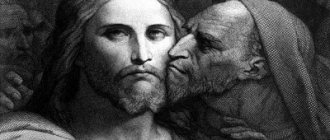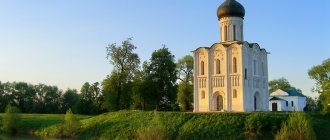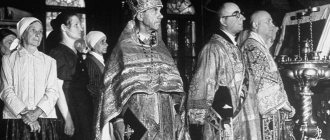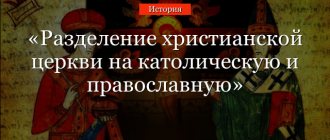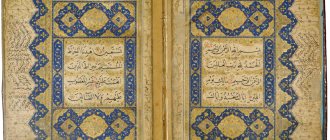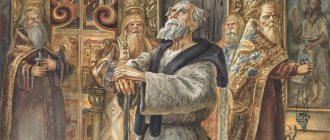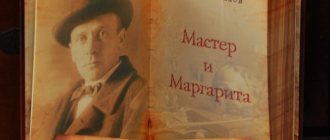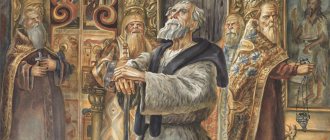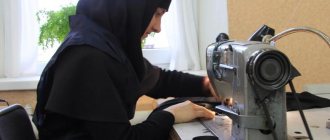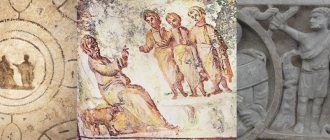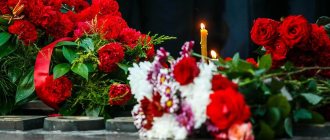Along with Orthodoxy, Rus' also borrowed painting from Byzantium, which until the 17th century was limited to church icons and frescoes. Initially, the temples were decorated by Byzantine masters or their students. But at the end of the 14th century, icon painting in Ancient Rus' began to develop rapidly: talented domestic masters began to create their own techniques and move away from the canons. Read what five famous artists brought to church art and how the style of Russian icon painting changed during the 14th–17th centuries.
Feofan the Greek
Theophanes the Greek. Savior Almighty. 1378. Church of the Transfiguration, Veliky Novgorod
Theophanes the Greek. Deesis rank. Our Lady. 1405. Annunciation Cathedral of the Moscow Kremlin, Moscow
Theophanes the Greek. Don Icon of the Mother of God. 1382–1395. State Tretyakov Gallery, Moscow
The icon painter Theophanes the Greek was born in Byzantium in 1340. Until the age of 30, he painted temples in Constantinople, Chalcedon and Galata; these works have not survived.
The artist sometimes departed from the iconographic canon of that era. He complemented the images with individual details, drew the contours of figures and folds of clothing, brightened the faces and made them brighter against the background of black or reddish-brown robes. The saints on his icons appeared to have realistic human features.
The free style of Theophanes the Greek did not correspond to the strict Byzantine academicism, and in the 1370s he came to Novgorod, where he became a famous master. In 1378, by order of boyar Vasily Mashkov, the artist designed the Church of the Transfiguration on Ilyin Street in one summer. Many frescoes have survived. The largest is the image of the Savior Almighty in the dome. He is wrapped in a blue tunic, holds the Gospel in one hand, and blesses with the other. Seraphim flutter around, and in the drum, the base of the dome, forefathers and prophets are depicted.
In the early 1380s, Theophanes the Greek moved to Moscow, by which time he had already formed his own school. Together with his students, the icon painter painted the temples of the Moscow Kremlin; the original frescoes were recreated by the artist’s followers. It is also believed that it was Theophanes the Greek who wrote the Deesis order of the modern iconostasis of the Annunciation Cathedral. Theophanes the Greek expanded it to 11 figures, and also depicted them in full height for the first time in Russian icon painting.
The Don Icon of the Mother of God is attributed to his brush. There is a hypothesis that the icon was created in 1392 for the Assumption Cathedral in Kolomna. It belongs to the Tenderness iconographic type, in which the baby is pressed against the cheek of the Virgin Mary and holds on to her cape. However, there are nuances on the Donskaya Icon: Jesus kneels on the left wrist of the Mother of God, blesses with his right hand, and holds a scroll in his left hand.
Masterpieces of world painting... The split through the eyes of Russian artists
The church schism of the mid-17th century is one of the most dramatic events in Russian history. Disputes about why this happened, and whether such a violent disengagement was inevitable, are still ongoing.
Without a doubt, the origins of the Schism go back to the Troubles. Its events shocked contemporaries, forcing them to rethink many ideas and values. At the same time, it was impossible for everyone to imagine that everything happened against the will of the Almighty. The mournful question “For what?” rested on the well-known answer: “For our sins!” However, the catastrophic scale of the disaster required explanations of a completely different depth. The very idea of collective guilt, which the participants in the events came to, required not just nationwide repentance, but a search for means for universal healing - moral and spiritual renewal.
Miloradovich Sergei Dmitrievich (1851-1943). “Black Cathedral. The revolt of the Solovetsky Monastery against newly printed books in 1666.” 1885. Tretyakov Gallery. Canvas, oil. 135-189 cm.
Lessons from the Time of Troubles. The Troubles significantly increased the degree of messianic self-awareness - especially among spiritual ascetics. The latter have always been in Rus'. The environment did not always respond to their calls. However, after the Time of Troubles, the thought of the coming Last Judgment did not let people go. It is no coincidence that this was an era of intensive church construction: representatives of the propertied classes, in atonement for present and future sins, hurried to build churches at their own expense with the hope that this would be credited to them at the Last Judgment. For ascetics, the final part of the famous formula of Elder Philotheus: “There will never be a Fourth Rome” became especially relevant. This meant that if the Russian people, having forgotten the lessons of the Troubles, continue to sin, then a new punishment of the Lord will inevitably follow, this time irrevocable, because the patience of our Lord is unlimited. And then the last Orthodox kingdom will collapse, in which only the true faith could exist in all its fullness and purity.
Nikon at the Spassky Gate after leaving the patriarchal see in 1660.
The ascetics were afraid of people's vacillation in faith and their inability to live up to the Christian ideal. The hard times we experienced blurred the halftones, leaving room only for a black-and-white assessment. Wherever the preachers turned their gaze - from the performance of rituals and church services to the moral state and behavior of the clergy, everywhere they saw the lack of proper zeal and zeal for the true faith. Lack of faith, loss of grace - this is the diagnosis that ascetics gave to Russian society. Then they developed a “treatment regimen.” This drug, scientifically called reform, was the only way to salvation, the fulfillment of the high mission destined for the Third Rome.
The circle of the royal confessor. The reform program took shape gradually: the first impulses came from individuals who dared to talk about the disorders in the church and in society. A little time passed - and a center appeared, to which the eyes of the majority of ascetics turned - the “circle of zealots of piety”, which gave its name to the entire movement. Stefan Vonifatiev, archpriest of the Kremlin Annunciation Cathedral and confessor of Tsar Alexei Mikhailovich Romanov, became the recognized leader of the zealots (they are also called God-lovers). The strength of the archpriest was that he had a strong influence on the sovereign, who, together with his mentor, dreamed of transforming Moscow into a truly Christian kingdom. Devoid of ambition, the royal confessor did not abuse his position, was meek and not at all power-hungry, and was alien to any envy. He tried to smooth out the rough edges in the disputes between zealots and the episcopate about changes in the church.
V. G. Shyvarts. Procession on a donkey.
Since the fall of Constantinople (1453), it was customary to look with great suspicion at the Greek clergy, which had fallen under the power of the non-Christian Turks, and to deny them the purity of Orthodoxy. The tsar’s confessor (Stefan Vonifatiev), on the contrary, welcomed immigrants from the East who had become skilled in disputes with Catholics, Uniates and Protestants. It did not bother him that their theological knowledge was acquired in Jesuit schools and colleges. So Archpriest Stefan wanted to destroy the wall that his predecessors had erected between the Russian Church and the Ecumenical Church. His Majesty Alexei Mikhailovich was vitally interested in establishing order and building a system of uniformity, both in the church and in the state, for which the zealots so energetically and ardently advocated. In addition, the young king liked the role of the second Constantine the Great, which the Greek clergy promised him. The Greek clergy skillfully played on the Quiet One’s vanity, calling on him to rescue Constantinople from Ottoman “captivity.” The king’s head was spinning from such flattering speeches. He felt himself to be the defender of all Orthodoxy, the builder of the one and only Orthodox kingdom.
The Tsar and the Patriarch in the book census workshop.
But such a project required overcoming existing religious differences, because in the understanding of Russian people, unity is unattainable without uniformity. And since the rituals of the Russian Orthodox Church could not be extended to other churches, one should have done the opposite, adopting Greek rituals, services and rites. Grecophile views, which made it possible to overcome the isolation in which the Moscow church found itself, were close to Alexei Mikhailovich. Both Archpriest Avvakum and Patriarch Nikon felt like new apostles. Inflexibility and fanaticism – these are the traits that its main participants brought to the confrontation. Therefore, it is natural that the confessor Stefan, who was prone to reconciliation, and who was also burdened with years, found himself on the sidelines. The capital's clergy adhered to Grecophile views and were determined to “rehabilitate” the Greek Church. While the provincial clergy was greatly irritated by the condescension towards the Greeks, they believed that only the Russian Church retained true piety. And, therefore, it does not need to borrow (for there is no one to borrow from), but only to correct what was “dirty” by alien influence. Here lies the reason for the split in the Russian Orthodox Church. For the time being, the tasks of moral and religious renewal of society after the Time of Troubles pushed all these differences into the background.
Vasily Grigorievich Perov. “Pustosvyat. Dispute about faith." 1881.
The lovers of God advocated for the performance of services without any concessions; for the moral renewal of the clergy, who, through their behavior and attitude towards pastoral duty, should be an example for the laity; for the healing of believers who, under the guidance of good shepherds, will be able to forever renounce sinful acts and pagan inclinations. Above all, lovers of God placed the Divine word and church service. Hence their decisive rejection of polyphony (simultaneous performance of different parts of the service (wedding, for example, and funeral service) in order to shorten the time of the service), because in this cacophony the splendor of what was happening and the meaning of what was said were lost.
Not all the clergy were delighted with the plans of the zealots of the faith, and there were reasons for this: feeling themselves to be prophets, the lovers of God dared to denounce even the episcopate. This was already an unacceptable oblivion of the church hierarchy. In this case, accepting the program of the zealots meant admitting that they were right! There were other considerations for rejecting the initiative of the God-lovers: their idea did not fit well with the routine of Russian life. The laity demanded leniency: the habit of sinning (drunkenness, for example, or committing adultery), and then receiving forgiveness from the confessor was closer to them than the sinless life to which the zealots called. Priests who dared to serve unanimously were reproached by parishioners: “You’ve been singing for a long time!” - and went to those temples where polyphony was practiced. The welfare of the white clergy directly depended on the parish, on alms. Moreover, the long service was a burden for them too.
Patriarch Nikon with the brethren of the Resurrection New Jerusalem, one of the three monasteries he founded. 1660
The first clash between zealots and bishops occurred in 1649. Patriarch Joseph refused to support the zealots, and they turned for help to the Patriarch of Constantinople, who supported them. The Moscow Patriarch was forced to accept the decision of the Patriarch of Constantinople, but was in no hurry to implement it. It was then that it became clear that reforms of the faith according to the plan of the zealots were possible under the new patriarch. There were several candidates for patriarch, but the main one was the tsar’s “dog friend” – Nikon. In 1649, he already occupied second place in the hierarchy of the Moscow Patriarchate, heading the Novgorod Metropolis. In the same year, at his invitation, a group of monks versed in Greek and Latin arrived from the Kiev Pechersk Lavra. The monks brought with them a lot of church literature, published in printing houses in Venice and Krakow. They promptly began to admonish the local cadres about the incorrectness of the Moscow church books, and their correction is a matter pleasing to God. The rector of the Kiev-Mohyla Academy himself, Peter Mohyla, at one time graduated from the Lviv fraternal school, under the leadership of the Jesuits, and was an ardent supporter of Polish culture. Of course, this state of affairs did not cause approval among the zealots - they considered Kiev Orthodoxy to be corrupted by the influence of the Jesuits. Confusion arose in the heads of the lovers of God - they were perplexed: by whom and when were the books damaged - Moscow did not know heretical kings, no heresy had ever won in Moscow. The zealots contributed to Nikon becoming the patriarch, but they put forward a condition for him - to implement the plans of the zealots. It should be noted that Nikon established unanimity in his diocese, was strict, exacting and energetic, thereby giving hope to the zealots. Nikon demanded extraordinary powers for himself (to take part in state affairs, for example; he received, like Patriarch Filaret, the grandfather of Tsar Alexei Mikhailovich, the title “great sovereign”). Enormous power was concentrated in Nikon's hands. He served as a simple monk in Russian northern monasteries, and went through a harsh management school with the local abbots - absolute obedience to his elders. Nikon was able to become patriarch only after the death of Joseph in 1652.
Kivshenko Ivan P. “Patriarch Nikon offers new liturgical books.”
Having risen to the top level of the church hierarchy, the patriarch began to demand complete obedience to himself. In 1653, he sent out a “Memory” to churches about replacing prostrations during prayer with the sign of the cross and the sign of the cross with three fingers. Thus began the church reform that led to the Schism. Nikon’s recent comrades in the “circle of zealots of piety” strongly protested the changes in the charter. Tsar Alexei the Quiet stood up for Avvakum Petrov and John Neronov. Others were unlucky: they were cut off and sent to distant northern monasteries. Further - more: Nikon carried out reforms, taking as a basis the charter adopted by the Ecumenical (Constantinople) Patriarchate, ordered to correct the Russian liturgical books, taking the modern Greek originals as a model. The zealots took up the pen, addressing their messages not only to the clergy, but also to the laity. So gradually theological disputes became the property of the street.
Kirill Kiselev. "Split".
At the height of the sharp controversy between the patriarch and the zealots, a cooling occurred between Patriarch Nikon and Tsar Alexei Mikhailovich. Because of these relations, Nikon intensified repressions against zealots: in 1656, in the Assumption Cathedral of the Kremlin, an anathema was proclaimed against those who cross themselves with two fingers, all of them were excommunicated. The physical elimination of dissidents began. The bishops, opponents of Nikon, were frightened and urgently adopted the reform. In 1658, disagreements between the tsar and the patriarch reached their climax: Nikon left the patriarchal see in Moscow (he was sure that the tsar would persuade his Holiness “not to be shy,” but His Majesty accepted and agreed with this) and retired to the Resurrection New Testament, which he founded. Jerusalem Monastery. At a council convened soon after, the metropolitans decided to deprive him of the patriarchate and priesthood. But Nikon, being an excellent polemicist and a good theologian, managed to ensure that he was judged only by his equals in rank, that is, the patriarchs of other Eastern churches. The arrival of these patriarchs lasted for eight years, and adherents of the old faith continued to be persecuted. The Old Believers' resistance to the new faith was equivalent to a rebellion against the sovereign.
Vasily Surikov. "Boyaryna Morozova". 1887.
Having broken off relations with Nikon, the tsar did not abandon his reforms, as the adherents of antiquity had hoped for: the tsar saw in these changes the path to what Nikon opposed—to the power of the “kingdom” over the “priesthood.” After Nikon's disgrace, Avvakum could count on the royal favor, but on an important condition - to join the reformed church or at least not to criticize it. However... the archpriest (the highest rank in the white clergy) was not going to do just this. In the end, Nikon in December 1665 made a mistake, which became the final one and led him to an irrevocable break with the tsar: he intended to directly, bypassing His Majesty, turn to the Patriarch of Constantinople Dionysius, so that the patriarch would become an arbiter in his dispute with Alexei Mikhailovich. For this purpose, Nikon sent his man with the embassy of Hetman Ivan Bryukhovetsky. The secret man was caught, and on the rack he pointed at the patriarch. Alexei the Quiet could not tolerate such “washing dirty linen in public and complaining about oneself.”
In 1666, the Patriarchs of Antioch, Macarius, and Patriarchs of Alexandria, Paisius, as well as a representative of the Patriarch of Constantinople, came to Moscow. They were summoned to Moscow to try Nikon and, at the same time, to condemn the leaders of the schism. Leaders of opponents of Nikon's reform, including archpriests Avvakum Petrov and Ioann Neverov, were brought to the cathedral. This was the largest, in the pre-Synoid period, in the history of the Russian Orthodox Church. At the council, the leaders of the Old Believers were excommunicated from the church, Patriarch Nikon was condemned and defrocked, and the decisions of the Stoglavy Council of 1551, by whose decisions the Russian Church lived, were condemned. All Orthodox antiquity, of which the Russian people were so proud, was rejected. As a result, the feelings and faith of many Russian people were humiliated and insulted. This could not happen without consequences. By turning supporters of the old faith into criminals and handing them over to punitive authorities, the council took another tragic step in strengthening the schism. This step no longer left any paths for compromise; to find agreement there was only enmity and discord.
In the Museum of the Moscow Theological Academy, among the paintings of Vasnetsov, Polenov, Nesterov, there is a small painting illustrating one of the pages of Russian church history - “The Trial of Patriarch Nikon.” This is the work of Sergei Dmitrievich Miloradovich; his works are exhibited in the State Tretyakov Gallery, the State Russian Museum, the Pushkin Museum and some other museums.
If at first the conflict arose on religious grounds, then after the Great Moscow Council such a phenomenon as schism acquired a social dimension. The 17th, Rebellious, century (the Troubles at the beginning of the century, the Bolotnikov uprising, the Salt and Copper riots, the uprising of Stepan Razin, the Church Schism) was characterized by endless wars, increased tax oppression, arbitrariness and extortion of officials of all ranks, and the growth of feudal duties. The popular discontent that had accumulated over the years found an outlet in the ideology of the Schism. Over time, social protest rushed into the spiritual direction proposed by the leaders of the schism with a completely different type of confrontation than open rebellion. The incomparably more severe reforms of Peter the Great led to riots an order of magnitude weaker than the urban unrest of the mid-17th century (Salt and Copper riots): the energy of social protest was spent by the first generation of schismatics, and then took on the character not of struggle, but of flight from the “kingdom of Antichrist”, appeared in the guise of Tsar Peter.
The impoverishment of faith was one of the consequences of the Schism: people who sincerely believed became Old Believers, which cannot always be said about those who remained in the bosom of the official church. After all, the Old Believers do not mean a quiet life and career within the framework of the dominant church, but eternal persecution and double taxes. The failure of the churchization program, which was advocated by the zealots of piety, should have led to the triumph of the opposite tendency - secularization, which resulted in a drop in the degree of religiosity. And in this regard, all lovers of God were initially doomed to defeat: they resisted the winds of time blowing in Russia towards enlightenment and secularization.
The schism weakened the position of the church in society and in the state. The Church was forced to again seek help and protection from the sovereign. Reform and schism, the fall of Nikon, the abolition of the patriarchate and the establishment of the synod, the final formation of absolutism - all these were links in one chain.
The monks of the Solovetsky Monastery refused to perform religious rites according to the new books. In 1666, the Tsar sent the abbot of the Yaroslavl Spassky Monastery, Archimandrite Sergius, to the monastery, who was supposed to deal with the situation “on the spot” and force the Solovetsky monks to accept the reform. Bishop Sergius also brought the order of the Great Moscow Cathedral to submit to the highest church authority. Supporters of the old rituals and rules persist... Bishop Sergius arrived at the monastery accompanied by armed archers, who were not allowed into the walls of the monastery, and a dispute was held with the archimandrite himself and his companions, vividly depicted in the painting by the artist Sergei Miloradovich “The Black Cathedral. …” (1885). In February 1666, the “Black Council” decided to beat the tsar with his forehead in order to cancel the church reform of Patriarch Nikon, and they promised to stand for the old faith until the end of their lives. Back in 1657, updated service books were delivered to the holy monastery from Moscow, which the brethren left sealed, and services were conducted as before. The elders did not heed the resolution of the Moscow Council (1667) to anathematize the Old Believers. In 1668, the tsar, angry with the Solovetsky elders, sent archers to pacify the rebellious monastery. It should be reminded that in Rus' all monasteries, first of all, were well-fortified fortresses, having a fire reserve, a supply of provisions, squeaks, cannons, self-propelled guns, cannonballs, potions (gunpowder). To strengthen their spirit even more, the monks threw new books into the water... The “Solovetsky Sitting” lasted until 1676. The Pomors actively supplied the inhabitants and monks (425 people) with food. In the early 1670s, participants in the uprising of Stepan Razin also joined the defenders of the monastery. The besieged often made daring forays. The fugitive Don Cossacks supervised the construction of fortifications. In 1676, the archers, as unreliable and sympathizing with the monks, were replaced by mercenaries; two governors who failed to cope with the task were replaced by governor Ivan Meshcherinov. Only the betrayal of the monk Theoktistus accelerated the brutal suppression of the rebellion in January 1676. The reprisal against the rebellious defenders of the old faith was fierce: Bishop Nikanor, for example, was taken outside the monastery walls in his underwear in the bitter cold and thrown into a ditch. The old man died by morning.
1- “Black” priest Gerontius stood on a chair and taught not to deviate from the old books; 2 - Bishop Sergius with his two companions sits opposite Archimandrite Nikanor; 3 - Lord Nikanor knocks on the table with his fist and shouts: “We will die for Az!” Vladyka Nikanor expressed a desire to go to Moscow to the Tsar and “suffer” for everyone; 4- the action of the picture takes place in the Church of the Transfiguration on Solovki, where the Black Cathedral met; 5- The monastic inhabitants and workers came to listen to the speeches of the monks.
Miloradovich Sergei Dmitrievich. (1851-1943). The son of a deacon, he studied at the Moscow Theological Seminary, where he began drawing. He continued his artistic education at the Stroganov School and at the Moscow School of Painting, Sculpture and Architecture. His teachers were the famous Itinerant artists Vasily Perov and Illarion Pryanishnikov. Subsequently, Miloradovich devoted a lot of time to teaching work. He taught at the Moscow School of Icon Painting, taught drawing classes at the Moscow Theological Seminary, and at the Moscow School of Painting, Sculpture and Architecture. For “fame in the artistic field” Sergei Dmitrievich was awarded the title of academician. Miloradovich was a member of the Association of Traveling Art Exhibitions, was a full member of the Imperial Moscow Archaeological Society, and was a member of the commission for the repair and restoration of the Assumption Cathedral of the Moscow Kremlin.
The artist's first historical painting was shown at the Traveling Exhibition in 1885. Acquired by Pavel Tretyakov. When creating the painting, the artist used authentic archival materials on the history of the schism of the Russian Orthodox Church, which occurred under Patriarch Nikon, during the reign of Alexei Mikhailovich, and visited the Solovetsky Monastery. This picture became iconic in the work of Miloradovich. Firstly, they started talking about her in newspaper and magazine circles. Secondly, it turned out that Kramskoy noticed and praised the picture. In Soviet times, due to his advanced age and declining demand for religious painting, he retired from active artistic activity, but continued to teach in various educational institutions.
1-What historical event is depicted in Miloradovich’s painting?
2-In Kivshenko’s painting “Patriarch Nikon offers new liturgical books,” find the king, patriarch and archpriest Avvakum.
3-Name the reason for the Schism.
Andrey Rublev
Andrey Rublev. Epiphany. 1425–1427. Trinity Cathedral of the Holy Trinity Sergius Lavra, Sergiev Posad, Moscow region
Andrey Rublev. Trinity. 1400s. State Tretyakov Gallery, Moscow
Andrey Rublev. Nativity. 1410s. Annunciation Cathedral of the Moscow Kremlin, Moscow
Andrei Rublev was a student of Theophanes the Greek. Chroniclers first mention him in 1405: then, together with his teacher and a certain Prokhor from Gorodets, he painted the Annunciation Cathedral. Rublev is considered the author of seven holiday icons. They, according to the painter Igor Grabar, were painted by “an artist obsessed with colorful quests and able to not only take the first bright combinations that came to mind, but combine them into a harmonious impression.” Rublev subtly painted the transitions from light to shadow, avoided glare and accurately drew details, and also added emotionality to the images, for example in “The Nativity of Christ” and “The Baptism”, where the angels bow before Christ. These techniques were new to painting at that time.
In May 1408, the icon painter, together with Daniil Cherny, decorated the Assumption Cathedral in Vladimir with frescoes and icons, after which he became a famous Russian master - he was commissioned to paint the new main icon of the Trinity-Sergius Monastery. The famous “Trinity” repeated the usual composition: three messenger angels sit at a table during a visit to the house of Abraham and Sarah. They came to announce that Sarah would have a son. Visually, the figures of angels form a circle - a symbol of the unity of the Father, Son and Holy Spirit. However, Rublev omitted some details that were previously included in the composition. There are no Abraham and Sarah on the icon, and the attributes of the meal and elements in the background are minimized and play only the role of symbols. This image of the Holy Trinity became a new canon in Russian icon painting.
Rublev probably painted not only the main icon. According to art critic Engelina Smirnova, his style can be traced throughout the iconostasis of the white stone Trinity Cathedral.
LiveInternetLiveInternet
Quote from Bo4kaMeda message
Read in full In your quotation book or community!
Orthodox life in paintings by Russian artists
ORTHODOXY
Pavel Ryzhenko “Prayer” Perov V.I. “Sermon in a village” 1861 A. Shilov.
“Before the Lamp” M.V. Nesterov. “The Hermit” 1888 I. Kramskoy “Head of a Monk” Kustodiev Boris Mikhailovich Portrait of a priest and deacon (Priests. At a reception). 1907 The priest of the church of the village of the Mother of God Peter and the deacon Pavel Levitam Isaac Ilyich posed. At the church wall. 1885 Matveev Nikolai Sergeevich. Sheared against her will. 1887 Miloradovich Sergei Dmitrievich. Nun at the iconostasis. 1922 Nesterov Mikhail Vasilievich. Monk. 1913 A. Shilov. Portrait of Bishop Vasily (Rodzyamko) Pryanishnikov Illarion Mikhailovich. At the church. 1867 Repin Ilya Efimovich. Protodeacon. 1877 Ryabushkim Andrey Petrovich. In the village. For mass Timm Vasily Fedorovich. Kneeling prayer with Filaret V. Tropinin. Monk with a candle. 1834 Schwartz Vyacheslav Grigorievich. Patriarch Nikon in New Jerusalem. 1867 Shukhvostov Stepam Mikhailovich. Internal view of the Alekseevskaya Church of the Miracle Monastery Bogdanov-Velsky Nikolai Petrovich. Wedding. 1904 Spiritual nourishment. Navozov Vasily Ivanovich Zhukov Dmitry Egorovich. Dispute about faith K. Lebedev. Baby baptism. K.F. Beaudry. Procession of the cross at the Annunciation Cathedral in the Moscow Kremlin. 1860 Korzukhin Alexey Ivanovich. Before confession. 1877 Kostandi Kiriak Konstantinovich. Blooming lilac. 1902 Koshelev Nikolai Andreevich. Children rolling Easter eggs Lebedev Klavdiy Vasilievich. Forced tonsure. 1896 M.I. Ignatiev. And life is so good Makovsky Vladimir Egorovich. Prayer service for Easter. 1887-1888 Maksimov Vasily Maksimovich. Trying on a chasuble. 1878 Miloradovich Sergei Dmitrievich. At confession. 1913 Unknown artist. Nun Susanna (Ryleeva) teaches children. Morozov Alexander Ivanovich. Exit from the church in Pskov. 1864 Myasoedov Grigory Grigorievich. Prayer service during drought. 1880 Nevrev. Protodeacon proclaiming longevity at merchant name days. 1866 Nesterov Mikhail Vasilievich. Vision to the youth Bartholomew. 1889-1890 Popov Andrey Andreevich. Booths in Tula during Holy Week. 1873 Repin Ilya Efimovich. Refusal to confess. 1879-1885 Ryabushkin Andrey Petrovich. Russian women of the 17th century in church. 1899 Solomatkin Leonid Ivanovich. Name day of sexton Leonid Ivanovich Solomatkin. On the choir Alexey Stepanovich Stepanov. Conversations of the godmother https://alchevskpravoslavniy.ru/kartiny/pravoslavna...nax-russkix-xudozhnikov.html/2
Dionysius
Dionysius and the workshop. Our Lady Hodegetria for the Ascension Monastery of the Moscow Kremlin. 1502–1503. State Russian Museum, St. Petersburg
Dionysius and the workshop. Deesis rite of the Assumption Cathedral of the Moscow Kremlin. Archangel Gabriel. Around 1502. State Russian Museum, St. Petersburg
Dionysius and the workshop. Descent into hell. 1502–1503. State Russian Museum, St. Petersburg
Dionysius is an icon painter of the second half of the 15th century, who continued the tradition of Andrei Rublev and finally shaped the style of the Moscow school. On the icons of Moscow artists, the figures of saints became thinner, longer and more graceful, and the colors became brighter and cooler.
Dionysius received his first commission between 1467 and 1477 - together with his teacher Mitrofan, he painted the Church of the Nativity of the Blessed Virgin Mary in the Pafnutyevo-Borovsky Monastery. In 1481, the master painted the Deesis order for the iconostasis of the Assumption Cathedral in the Moscow Kremlin and became a favorite of Ivan III. The works of Dionysius were bright and ceremonial. In 1482, he was commissioned to paint “Our Lady Hodegetria” for the Ascension Monastery in the Moscow Kremlin. The image turned out to be majestic: a solemn pose, a purple robe, a light golden background and angels around.
The most monumental work of the painter is the painting of the Cathedral of the Nativity of the Virgin Mary in the Ferapontov Monastery. Dionysius was helped with her by his sons Theodosius and Vladimir. The frescoes with scenes from the earthly life of the Virgin Mary - “The Intercession”, “The Cathedral of the Virgin Mary”, “Rejoices in You”, “The Last Judgment” - were made in a color scheme unusual for those years: light and pure tones of greenish-blue, gold and white. The ensemble was perfectly preserved because the monastery did not have the means to repaint the walls - this was usually done when the colors faded or fashion changed.
Dionysius painted everyday icons of many saints. In the center of such works there was an image of the monk, and around there was a frame with scenes from his life. The most famous are the paired icons of Metropolitans Peter and Alexei: the figures on them are depicted in full height in ceremonial attire and are symmetrical to each other.
Soviet painting
Among the variety of Russian paintings, a special place is occupied by works depicting various architectural objects. Most often these are architectural monuments - temples and monasteries - that have attracted the attention of artists for centuries, but often the theme for sketches, and sometimes large paintings, are seemingly insignificant buildings or even elements of buildings, such as windows, arched openings or columns. Not attracting too much attention in reality, transferred to the canvas by the hand of a master, they become a finished work and attract the eye no worse than genre painting or portraits.
By deciding to buy ready-made paintings that in one way or another reflect the theme of architecture, connoisseurs of the Russian school of painting will have a rare opportunity to see with their own eyes the continuity of generations. Churches and monasteries often became the subject of works by Soviet artists, but modern authors also turn to this topic. Soviet painting gave the world such works as “The Church in Ostankino” by Igor Rubinsky, “The Cathedral in Suzdal” by Enver Ishmametov or “The Monastery” by Vladimir Gremitsky. It is no coincidence that each of these works shows the viewer precisely winter time. Muted, cold colors and the absence of flashy bright details remind us that churches and monasteries are primarily spiritual abodes, and not architectural attractions for the development of tourism. By adding such a painting to your home interior, art lovers will be able to enjoy the strict simplicity of architectural forms and the excellent technique of Soviet painting masters.
Modern authors, having “taken over the baton” from the previous generation, also cannot refuse to depict cathedrals and churches. Current paintings by artists dedicated to this topic are distinguished by a constant search for innovation. Works appeared written from an unusual angle, such as “Bolkhov. View from the bell tower" by Olga Sorokina or "Nizhny Novgorod. View of Rozhdestvenskaya Street" by Daria Vorobyova. The viewer seems to get the opportunity to catch a glimpse of the churches from above, catch the glare of light on the golden domes and see the outlines of the city around the temple. Other authors have focused on the play of light. Yuri Aniskin’s painting “Assumption Cathedral at Sunset” surprisingly accurately conveys the soft glow of the setting sun reflected from the walls of the Astrakhan Kremlin cathedral. The same theme is visible in the work of Igor Razzhivin with the poetic title “The sun is entangled in the trunks.”
Both in Soviet times and now, artists do not limit themselves to depicting Orthodox churches alone. The authors are attracted by the subtle beauty of oriental mosques and mausoleums. The world-famous Samarkand complex Shahi Zinda was captured by many Russian artists. Its azure domes were painted by Valery Kovinin, and Alevtina Kozlova was fascinated by the skillfully decorated arches of the mausoleums. Buying oil paintings on canvas depicting this architectural ensemble means introducing a subtle oriental note into the interior and giving yourself and your loved ones a unique opportunity to daily admire the heritage of bygone eras that has come down to us through the centuries.
Anna Kovaleva
Simon Ushakov
Simon Ushakov, Yakov Kazanets, Gavriil Kondratyev. Annunciation with Akathist. 1659. State Historical Museum, Moscow
Simon Ushakov. Savior Not Made by Hands. 1658. State Tretyakov Gallery, Moscow
Simon Ushakov. Tree of the Russian State. 1668. State Tretyakov Gallery, Moscow
The court painter Simon Ushakov worked in the second half of the 17th century. His works reflected the fashion for everything Western and introduced a new style into Russian icon painting. The faces of the saints became more rounded, their features softer, and their complexions approached a warm, flesh-colored complexion. The artist began to depict buildings as realistic. His works were reminiscent of Western European engravings, but the composition still remained conventional and there was no light source.
At first, Ushakov served as a “royal paid icon painter” and quickly became popular. In 1664, he already supervised the craftsmen of the Armory Chamber, the main art center of Russia at that time. Its artists painted palaces and churches, created icons and miniatures. It was Simon Ushakov who embodied the method of joint work: one artist came up with the composition of the icon, the second painted the faces of the saints, the third painted the clothes and background. Thus, Ushakov painted the icon “Annunciation with Akathist” together with Yakov Kazanets and Gavriil Kondratyev.
A typical example of Ushakov’s “life-like” icon is “The Savior Not Made by Hands” for the Moscow Trinity Church in Nikitniki. There, the artist created his own version of the Mother of God of Vladimir - “Tree of the Russian State”. On the icon, the roots of the tree “grow” from the Assumption Cathedral, portraits of twenty Moscow saints are inscribed on the branches in medallions, and in the center medallion there is an image of the Mother of God.
Russian art is the territory of Orthodox civilization
Russian painting, which voluntarily renounced the freedom and independence granted to it from the Church, grew by preaching the highest Christian values - virtues, which for the Russian people constituted the very essence of life in Christ.
Today, the question of the spiritual nature of Russian art is particularly acute and relevant. Already in the works of artists of the 18th century Losenko, Akimov, Ugryumov, Egorov and others, the main principles that determined the main path of development of Russian art, the Russian idea, manifested themselves. In their works, the masters of historical painting spoke of unity not on the basis of social and revolutionary transformations, and certainly not on the basis of Enlightenment chimeras: freedom, equality and fraternity. They proclaimed unity, conditioned primarily by the spiritual community of the people, all classes of which are connected by one history, one culture, one faith, one mental and spiritual way of life, which is based on mercy, meekness, courage, trust in God, and love - those Christian virtues that constituted the very essence of life in Christ.
Confronting the then excessive reliance on reason, the humanization of public consciousness, that is, its de-churching, the masters of historical painting of the 18th century preached Christian love, the triumph of virtues over passions, and reminded their compatriots of their “baptism and orthodoxy” (St. Demetrius of Rostov). And this despite the fact that on the pediment of the Academy of Arts there was an inscription: “Free arts,” that is, art that is free and independent of the Church.
N.N. Ge. What is truth. 1890
Unlike their Western colleagues, who, starting from the Renaissance, considered the Bible as a historical source, which opened up access to it for lay artists, Russian painters, on the contrary, strove for a religious spirit. But at the same time, following the same path as their European colleagues, they started not from the prototype, but from their own vision and understanding of the biblical or gospel story. With this approach, its sacred meaning, of course, remained undiscovered, and therefore the religious spirit and the preaching of virtues had nothing to be born from.
But the religious spirit that leaves works on a biblical story does not disappear. He simply moves into other genres in the work of the same master, where he is fully revealed as a character, as a way of perceiving the world.
Here, a clear example is the painting “Grand Duke Svyatoslav, kissing his mother and children upon returning from the Danube to Kyiv” (1773) by Ivan Akimov, a student of Anton Losenko. The painting is dedicated to the father of Prince Vladimir. However, it is no coincidence that the artist already in the title singles out the mother of the Grand Duke, the holy Equal-to-the-Apostles Princess Olga, recalling that she was the first Russian ruler to convert to Christianity even before the Baptism of Rus'. Here, next to his father, is his eldest son Vladimir, the future baptist of Rus'. It is to him in the picture that the pointing gesture of his grandmother, Princess Olga, is addressed. Thus, both in the title itself and in the nature of the compositional structure, the artist embodied the idea of spiritual continuity, which was extremely relevant for Russia during the Enlightenment, as the beginning of Russian statehood.
K.P. Bryullov. The last day of Pompeii. 1832
This leitmotif not only persists in the 19th century, but more and more asserts itself as a unique feature of Russian art. Regardless of what genre the master works in, his art itself will always testify to the primacy of religious consciousness, its dominance over artistic consciousness. And therefore, all the accents in the work will be dictated not by the logic of rational understanding of the chosen plot, but by the depth of thoughts and feelings, the spiritual life that the master lives based on Christian virtues.
And there is a pattern in the fact that the center of gravity turns out to be ordinary people, peasants. Already in Venetsianov’s work, it is they who for the first time become the main characters of the works, and the theme is their life and work. But for all that, the art of this self-taught artist is distinguished by a warm, loving attitude towards his characters, his ability to feel, hear, and see with his inner gaze their special world. A world in which, behind external impartiality, naturalness and simplicity, the fundamental principle that distinguishes the Russian people is hidden: its softness, femininity, passivity, contemplation. Perceived by the religious heart, this national element of the Russian people enters into Venetsianov’s paintings not with rampant passions, but with “highness of feelings,” in the words of V.A. Zhukovsky. Hence this special atmosphere of Venetsianov’s works, in which one can feel both the spiritual mood and spiritual contemplation, first introduced into Russian art by Venetsianov, and at the same time meekness, chastity and humility. It is to identify these virtues that subsequent generations of artists will strive as the main goal of their work. As soon as it appeared, spiritual contemplation immediately illuminated both the “free arts” themselves and the path along which their ascent began.
Just at the turn of the 1820–1830s. Religious sentiments began to intensify. And at the same time, a new understanding and awareness of both the artist’s mission and his art is being formed.
“The artist,” wrote one of K. Bryullov’s correspondents, “is a heavenly conductor of the high life of humanity. This is a divine ladder, on the steps of which bright thoughts and deep feelings descend and ascend, and at its height the Lord is established, for He is also the Lord of the Beautiful!” It doesn’t matter what path you cover this staircase with. It can be “baroque”, it can be “classicistic”, “romantic”, “realistic”, etc. For a Russian artist, the main thing is always that there is a ladder, since it also determines the vertical vector of art development in Russia.
I.N. Kramskoy. Portrait of I.I. Shishkina. 1873
In this regard, one cannot help but recall one of the outstanding works of Russian painting - “The Last Day of Pompeii” by K. Bryullov. A picture that programmatically reinforces this vertical. Bryullov, just like his predecessors, did not confine himself to the plot itself, did not immerse himself in its eventfulness. Like them, he uses the chosen plot only as an excuse for solving completely different problems. And it rises in their very formulation, and even more so in their solution, to hitherto unprecedented heights. He reveals to us a large-scale, universal panorama of the collapse of the old - pagan world and the birth of the new - Christian world, the symbol of which in the picture is a Christian priest with a censer and a chalice in his hands. Meanwhile, these are very important sacred vessels, without which there can be no worship. The censer itself means the humanity of Christ, filled with the fire of the Divine, and the fragrant smoke symbolizes the fragrance of the Holy Spirit, whose power revives us and constantly helps us. The chalice is the cup from which we commune, that is, on an individual level with God spiritually and physically, and in this sense we become brothers and sisters in Christ. In other words, the artist, among other things, pursues another important idea - the idea of Christian brotherly love, in which spiritual love is transformed into its spiritual hypostasis, reaching the highest step of the ladder of virtues.
I.I. Shishkin. Forest Cemetery. 1893
Thus, Bryullov reveals the deepest meaning of Christianity, emphasizing its fundamental difference from paganism. And therefore, it is here, towards the priest, who for the first time in both Russian and European art appears as a collective image of the Church of Christ, that the artist turns this entire crowd of running, fleeing people. And then the very idea of salvation takes on not only a physical meaning - as the salvation of life, but also a spiritual one - as the salvation of the soul.
If this evangelical idea is present in the most varied variations in works on a historical subject, then its fundamental significance for religious painting is all the more understandable.
And here, of course, the palm belongs to Alexander Ivanov. In his famous painting “The Appearance of Christ to the People,” he, unlike all his predecessors, does not give an interpretation of the plot, which he took from the 1st chapter of the Gospel of John. Ivanov uses it as an opportunity to speak out, express his religious feelings, thoughts, and experiences. Thus, for the first time in Russian art, a high, confessional note sounded, which was very quickly accepted by artists working in other genres, that is, it became a universal phenomenon. This is a very important point, which determined, perhaps, one of the main features of Russian art of the second half of the 19th century.
A fairly striking example is the painting by V.G. Perov "Seeing the Dead Man" It is distinguished not only by its emotional fullness and expressiveness, but, above all, it is a spiritual revelation of its author. For the first time in Russian art, it was Perov, who, as is known, began with criticism of the Church, but who experienced a kind of catharsis, spiritual transformation abroad, touched the most intimate, what is called the secret of the Russian soul. What is it? Humble bearing of your cross! That's the whole secret. It was Perov who gave a fundamentally new definition of “genre painting” as a reflection of “the character and moral way of life of the people.” A life in which humility, as one of the key Christian virtues, is defined by this image.
I.I. Shishkin. Windbreak. 1888
In this regard, it seems incorrect to consider his paintings solely from the point of view of their social orientation, since his works are not about the humiliated and insulted, but about the moral character of people who are humiliated and insulted.
Therefore, it is not surprising that the creation of a psychological portrait is also associated with the name of Perov. He managed in the portrait of F.M. Dostoevsky, again for the first time in Russian art, to reflect the spiritual world of man, which, in the words of the writer himself, determines “the main idea of the face.”
Hegel once remarked: “Philosophy is its time captured in thought.” To paraphrase the German philosopher, we can say that art is its time, captured in an image. Being in constant, direct dialogue with its time, Russian art sometimes expressed very important thoughts and ideas, but not directly, but with the help of Christian symbolism, in which, for example, a dry tree means the fall of man, his spiritual death, and a green branch or bush symbolize his spiritual rebirth. Historical painters were required to master this symbolism. But, as it now turns out, everyone knew this language well - even landscape painters.
I.A. Akimov. Grand Duke Svyatoslav kissing his mother and children upon returning from the Danube to Kyiv. 1773
In love with Russian nature, who knew how to see beauty in its simplicity, modesty or even severity, I.I. Shishkin, at the same time, perceived landscape painting, in his words, as “a silent, but warm, living conversation of the soul with nature and God.” Hence this spiritual warmth of his canvases, this grace spilled in them, their high poetry, spirituality. At the same time, his countless “Windbreaks” with trees uprooted, “Forest Cemeteries” with fallen trees, already covered with moss, like a shroud. Its hopeless wilderness with a closed space. Finally, his “Rye” and the 12 pine trees standing in it right in the middle of the field, of which one pine is withered, fallen off, immersed in emptiness, will evoke completely different associations. Ideas about the ideological richness of the art of this remarkable artist will begin to change, in whose works images of his contemporary society appeared, dressed in Christian symbolism: sick, spiritually unsettled, torn from the roots, with cold and weakened souls.
The originality of Russian art is also determined by the fact that it not only states the situation, making an accurate diagnosis of its sick time, but, which is very important, it immediately offers a method of treatment, that is, a way of salvation.
V.G. Perov. Seeing off the deceased. 1865
Regardless of the historical period, style, aesthetics and genre, Russian painters, using a specific life plot, recreating historical reality, sought, just like icon painters, to fill the artistic space of their canvases with spiritual reality. Doesn’t this postulate give rise to an equal sign between an icon and a painting, if there is so much in common between them in their very essence? No, it doesn't happen. An icon is born not as a fruit of inspiration, but as a captured revelation, representing the prototype that is revealed through fasting and prayer to the spiritual eyes of the icon painter. The spiritual reality of the icon and the painting is not identical, since the icon is filled with ideas and images of the heavenly world, and in the painting the artist, relying on church truths, expresses his attitude, his understanding of the reality around him, the world below. And although both of these realities, due to their purposefulness, are different, in essence we can talk about their internal unity, since the icon proclaims Christian values, while the artist in his painting affirms them as a measure of specific life realities, events and characters.
Thus, the spiritual reality of the icon and the painting correlate with each other, like cause and effect. It is this cause-and-effect relationship, carrying within itself a creative, spiritual principle, that holds domestic art from within: both icon painting and secular art, defining its internal inextricable unity. Not by letter. In spirit. This is the most important tradition of Russian art, its commandment.
V.G. Perov. Portrait of F.M. Dostoevsky. 1872
A spiritual perspective allows us to look at our art with new eyes and see phenomena that we did not even suspect existed. Confession, which we have already mentioned, revealed different understandings of the “God-saved path.” The point is not that everyone understood it in their own way, but that its interpretation was derived from the nature of the artist’s religious worldview. It was this that determined the nature of this path, where the artist searches for God. And here an interesting pattern arises.
Those artists who seek God in their hearts, as Christ bequeathed, they all, without exception, confess the Divine-Humanity of Christ, that is, they give primacy to His Divine nature. Those who seek God on the paths of enlightened reason, as a rule, confess the man-divinity of Christ, and then put Christ the man in first place. And if the art of the artists of the first group contains a creative principle, filled with enormous spiritual power - one that heals the soul, cleansing and protecting it from spiritual death, then amazing metamorphoses begin to occur with the artists of the second group.
A.G. Venetsianov. Peasant woman with a jar of milk. 1820s
Some lead Christ to atheism and even consider Him the first atheist. For others, Christ is primarily a scientist. For others, freedom in handling the image of the Savior even leads to the realization of the opportunity to write their own Gospel. Tolstoy is not an isolated case. But in the end, such a rational path of salvation, proposed by man himself, who deified his enlightened mind, leads to a loss of faith. Finding himself in a spiritual impasse, the artist suddenly, unexpectedly for himself, loses not only vital, but also creative support, which is why the works of even great masters turn out to be unfinished in this case.
A.G. Venetsianov. Self-portrait. 1811
This, in particular, is the fate of the famous painting by Alexander Ivanov, who had very little left to do: illuminate the painting with uncreated, Divine light. He, who had reached such transcendental heights here, such a spiritual flight of lofty thoughts, would have succeeded. But by that time, Alexander Ivanov, as an eyewitness to the bourgeois revolution of 1848, which equalized faith and atheism, began to imbue with the spirit of its liberal ideas. He suddenly began to become interested in the ideas of the theologian David Strauss, who argued that “neither in the personality nor in the activity of Jesus is there anything supernatural, nothing that would require a person to have blind, selfless faith and admiration for authority.” D. Strauss's book “The Life of Jesus” captivated Ivanov so much that he became engrossed in it. And he even quoted entire chapters from this book by heart, which even embarrassed the author himself. Naturally, the result was immediate: the artist lost faith. And his co-creation with God ended, his spiritual eyes closed. Having lost his bearings, Ivanov confessed to Herzen: “I lost faith, faith in God, which helped me live and work. The world of the soul is upset, find me a way out, show me ideals.” The painting, which the artist worked on for 25 years, remained unfinished.
A.G. Venetsianov. Peasant woman with cornflowers. 1830
Regarding this rational nature of faith, N.N. Ge in his painting “What is Truth?” expressed himself very precisely and insightfully: in the light of reason, God is not visible. But the same Ge, a little later admitted to L.N. Tolstoy that for 10 years he could not begin to write “The Crucifixion” because he could not understand what “The Crucifixion” was. But as a result of many years of friendship with the writer, whom he called his spiritual mentor, Ge finally understood, by his own admission, that the Crucifixion is when Christ dies on the Cross. And that means there is no soul, no salvation, no Resurrection.
Marina Petrova
Ultimately, we must admit that it was precisely this – rational – line that prevailed in the Russian public consciousness at the turn of the 19th and 20th centuries, leading, as we know, to very difficult, bloody consequences. That’s why we need to know this and talk about it, so as not to repeat those tragic mistakes that cost our country, our people, and our culture so dearly.
